Related Research Articles

Amber is fossilized tree resin that has been appreciated for its color and natural beauty since Neolithic times. Much valued from antiquity to the present as a gemstone, amber is made into a variety of decorative objects. Amber is used in jewelry and has been used as a healing agent in folk medicine.

In polymer chemistry and materials science, a resin is a solid or highly viscous substance of plant or synthetic origin that is typically convertible into polymers. Resins are usually mixtures of organic compounds. This article focuses mainly on naturally occurring resins.
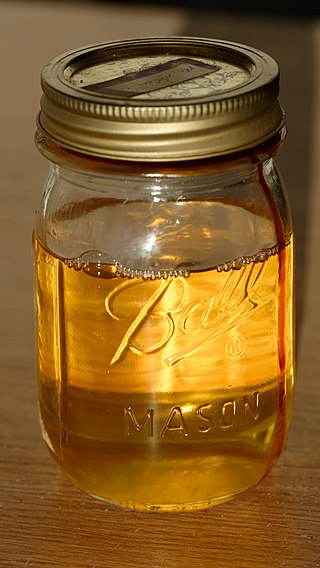
Turpentine is a fluid obtained by the distillation of resin harvested from living trees, mainly pines. Mainly used as a specialized solvent, it is also a source of material for organic syntheses.

Asafoetida is the dried latex exuded from the rhizome or tap root of several species of Ferula, perennial herbs of the carrot family. It is produced in Iran, Afghanistan, Central Asia, northern South Asia, and Northwest China (Xinjiang). Different regions have different botanical sources.
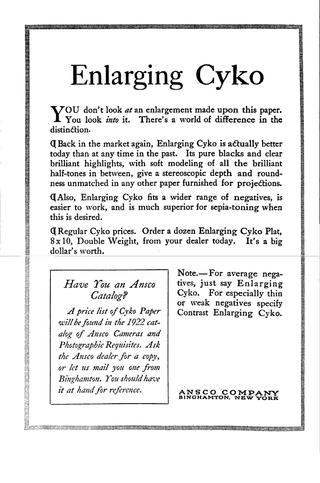
Photographic paper is a paper coated with a light-sensitive chemical formula, like photographic film, used for making photographic prints. When photographic paper is exposed to light, it captures a latent image that is then developed to form a visible image; with most papers the image density from exposure can be sufficient to not require further development, aside from fixing and clearing, though latent exposure is also usually present. The light-sensitive layer of the paper is called the emulsion. The most common chemistry was based on silver halide but other alternatives have also been used.

Epoxy is the family of basic components or cured end products of epoxy resins. Epoxy resins, also known as polyepoxides, are a class of reactive prepolymers and polymers which contain epoxide groups. The epoxide functional group is also collectively called epoxy. The IUPAC name for an epoxide group is an oxirane.
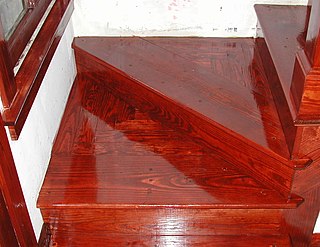
Varnish is a clear transparent hard protective coating or film. It is not to be confused with wood stain. It usually has a yellowish shade due to the manufacturing process and materials used, but it may also be pigmented as desired. It is sold commercially in various shades.

Lacquer is a type of hard and usually shiny coating or finish applied to materials such as wood or metal. It is most often made from resin extracted from trees and waxes and has been in use since antiquity.

Frankincense is an aromatic resin used in incense and perfumes, obtained from trees of the genus Boswellia in the family Burseraceae. The word is from Old French franc encens. There are several species of Boswellia that produce true frankincense: Boswellia sacra, B. frereana, B. serrata, and B. papyrifera. Resin from each is available in various grades, which depends on the time of harvesting. The resin is hand-sorted for quality.

Pinus echinata, the shortleaf pine, is a species of pine native to the southeastern United States.
Xanthorrhoea is a genus of about 30 species of flowering plants endemic to Australia. Species are known by the name grass tree.

Sir William Smith was an English lexicographer. He became known for his advances in the teaching of Greek and Latin in schools.
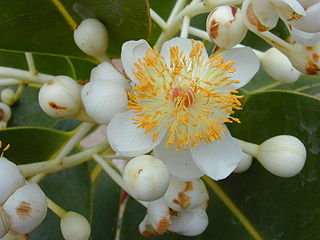
Calophyllum is a genus of tropical flowering plants in the family Calophyllaceae. They are mainly distributed in Asia, with some species in Africa, the Americas, Australasia, and the Pacific Islands.

Gamboge is a deep yellow pigment derived from a species of tree that primarily grows in Cambodia. Popular in east Asian watercolor works, it has been used across a number of media dating back to the 8th century. Easy to transport and manipulate into a durable watercolor paint, amboge is notable for its versatility as a pigment in how it has been used in paintings, printing of books, and garment dyes, including the robes of Buddhist monks. Though used in a number of different contexts, Gamboge is known not to react well with lime surfaces therefore making it unsuitable for frescos and with white lead. For its popularity, Gamboge has not been extensively identified in works of art from any time period; the few instances wherein art historians have attempted to identify whether or not the pigment was used in a given work have confirmed its widespread use and its longevity as staple within watercolor painting particularly in eastern art.

Encelia farinosa, is a common desert shrub of the southwestern United States and northern Mexico. It has a variety of historical uses.
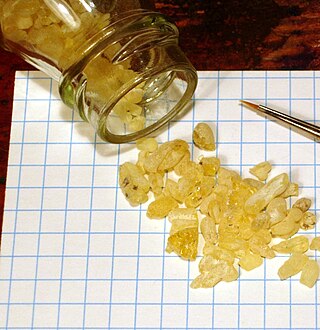
Sandarac is a resin obtained from the small cypress-like tree Tetraclinis articulata. The tree is native to the northwest of Africa with a notable presence in the Southern Morocco part of the Atlas mountains. The resin exudes naturally on the stems of the tree. It is also obtained by making cuts on the bark. It solidifies when exposed to the air. It comes to commerce in the form of small solid chips, translucent, and having a delicate yellow tinge. Morocco has been the main place of origin of sandarac. A similar resin is obtained in southern Australia from some species of the Australian cypress-like trees Callitris, but the resin has not been systematically collected in Australia.

Galbanum is an aromatic gum resin and a product of certain umbelliferous Persian plant species in the genus Ferula, chiefly Ferula gummosa and Ferula rubricaulis. Galbanum-yielding plants grow plentifully on the slopes of the mountain ranges of northern Iran. It occurs usually in hard or soft, irregular, more or less translucent and shining lumps, or occasionally in separate tears, of a light-brown, yellowish or greenish-yellow colour. Galbanum has a disagreeable, bitter taste, a peculiar, a somewhat musky odour, and an intense green scent. With a specific gravity of 1.212, it contains about 8% terpenes; about 65% of a resin which contains sulfur; about 20% gum; and a very small quantity of the colorless crystalline substance umbelliferone. It also contains α-pinene, β-pinene, limonene, cadinene, 3-carene, and ocimene.
Galipot is an impure resin of turpentine. It is obtained from pine trees by evaporation of the essential oil and once purified is called yellow pitch, white pitch or Burgundy pitch.
Wood glue is an adhesive used to tightly bond pieces of wood together. Many substances have been used as glues.

Charles Marriott was a rugby union international who represented England from 1884 to 1887. He also captained his country.
References
- ↑ One or more of the preceding sentences incorporates text from a publication now in the public domain : Chisholm, Hugh, ed. (1911). "Copalite". Encyclopædia Britannica . Vol. 7 (11th ed.). Cambridge University Press. p. 94.
- ↑ WordNet Dictionary (derived from the Webster's Revised Unabridged Dictionary (1913 version) by the C. & G. Merriam Co. Springfield, Massachusetts, USA).